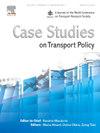Ready to ride: Security and transit-related determinants of ride-hailing adoption in Latin America
IF 3.3
Q3 TRANSPORTATION
引用次数: 0
Abstract
Previous research on ride-hailing has focused on the effects that the built environment, demographic variables, and personal attitudes have on the frequency of ride-hailing use, finding that adopters are mainly young and highly educated people with increased levels of technology embracement. Despite that some scholars have shown that the convenience of ride-hailing such as their flexibility and major geographical coverage has led to users to prefer services provided by Transportation Network Companies (TNCs) over public transportation for some trips, there is a lack of research on how perceptions of public transit systems and TNCs can induce ride-hailing usage. In this article we extend the understanding of ride-hailing phenomena by proposing that structural gaps in public transit are key explanatory variables in the uptake and willingness to pay for ride-hailing trips. Building on an international survey in Mexico City, Bogotá, and Medellín, we develop a Structural Equation Model (SEM) incorporating latent variables expressing perceptions people have about features of ride-hailing and vulnerabilities in public transit. Results show that these variables are relevant. We also confirm that educational attainment and income are instrumental for ride-hailing trips, and that technology embracement is the most important variable to distinguish among levels of adoption. Findings inform public policy by focusing on the negative experiences of using public transit and how this could be generating more ride-hailing trips. TNCs are an attractive transport alternative that can fill gaps in public transit systems but that are also benefiting from structural problems in the transit systems.
准备乘车:拉丁美洲网约车采用的安全和过境相关决定因素
之前关于网约车的研究主要集中在建筑环境、人口变量和个人态度对网约车使用频率的影响上,发现用户主要是受过高等教育的年轻人,他们对技术的接受程度更高。尽管一些学者已经表明,网约车的便利性,如灵活性和主要的地理覆盖范围,导致用户在某些行程中更喜欢由交通网络公司(TNCs)提供的服务,而不是公共交通,但缺乏对公共交通系统和跨国公司的看法如何诱导网约车使用的研究。在本文中,我们通过提出公共交通的结构性差距是乘车旅行的接受和支付意愿的关键解释变量,扩展了对乘车现象的理解。在墨西哥城、波哥大和Medellín进行的一项国际调查的基础上,我们开发了一个结构方程模型(SEM),该模型包含了表达人们对乘车特征和公共交通脆弱性的看法的潜在变量。结果表明,这些变量是相关的。我们还证实,教育程度和收入是网约车出行的重要因素,而技术接受程度是区分采用程度的最重要变量。研究结果通过关注使用公共交通的负面体验以及如何产生更多的乘车旅行来为公共政策提供信息。跨国公司是一种有吸引力的运输选择,可以填补公共运输系统的空白,但也受益于运输系统的结构问题。
本文章由计算机程序翻译,如有差异,请以英文原文为准。
求助全文
约1分钟内获得全文
求助全文

 求助内容:
求助内容: 应助结果提醒方式:
应助结果提醒方式:


